28 FEBRUARY 2011
YOUR WORDS
Readers are invited to add their comments to any story. Click on the article to see and add.
BTN DISTRIBUTION
BTN also goes out by email every Sunday night at midnight (UK time). To view this edition click here.
- COMMENT: Speed cameras
- Airline passenger claims
- Avis adds sporty car to hire fleet
- Baton Rouge hotel re-opens
- Boeing's "new" 747
- British Airways strike call
- City airport additions to BA portfolio
- Delta strengthens its position at Heathrow
- First Korean Air A380 rolled out of paint shop
- Indian hotel for Sofitel
- KLM to Buenos Aires
- London to lead world with ticketless travel
- Lufthansa adds to South American services race
- Luton airline's ecoflights
- Manx2 to end Belfast to Cork service
- Northern Ireland airport road
- Peter Joel of Pan Am passes away
- Swiss upgrades its First Class
- Toronto for Ritz-Carlton
- Travelodge expands
- Virgin Blue Business Class
- ON TOUR: Ash in Europe
- CRUISE NEWS February 2011
- AND FINALLY: Luton Airport introduces two new staff members
The Business Travel News
PO Box 758
Edgware HA8 4QF
United Kingdom
info@btnews.co.uk
© 2022 Business Travel News Ltd.
Avis adds sporty car to hire fleet
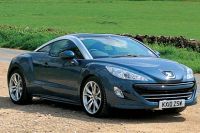 Peugeot’s sporty 308-based Peugeot RCZ two-door coupe will now be available to hire exclusively through Avis ‘Select Series’ scheme as it adds 75 of the new cars to its fleet. Launched by Peugeot in the UK last year, this is the first time that the car has been available to the car hire market.
Peugeot’s sporty 308-based Peugeot RCZ two-door coupe will now be available to hire exclusively through Avis ‘Select Series’ scheme as it adds 75 of the new cars to its fleet. Launched by Peugeot in the UK last year, this is the first time that the car has been available to the car hire market.
Avis ‘Select Series’ offers customers the opportunity to guarantee the make and model of their rental car choice, particularly appealing to motoring enthusiasts and the more discerning looking for a specific model. Having already received impressive reviews, including various accolades like Top Gear’s 2010 ‘Coupé of the Year’, the Peugeot RCZ with its distinctive double-bubble roof line is an apt addition to the existing Avis range.
The Peugeot RCZ is available to hire immediately from seven Avis Select Series locations across London and the South East, including the popular rental locations of Heathrow airport and Westfield shopping centre where there will be respectively 25 and 20 RCZ sport coupés available. The other London sites include Earl’s Court, Euston, Victoria, Waterloo, and Gatwick Airport. www.avis.co.uk
British Airways strike call
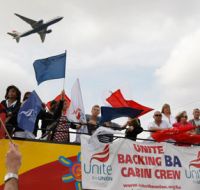 Unite, the union representing the majority of British Airways cabin staff, is organising yet another ballot, the fourth. The call is for a strike, or series of strikes, during the busy April period, which includes Easter. In spite of stepping down as Chief Executive (he now holds the same position with parent company IAG) Willie Walsh will remain in charge of negotiations leaving the new CEO Keith Williams dealing with other matters.
Unite, the union representing the majority of British Airways cabin staff, is organising yet another ballot, the fourth. The call is for a strike, or series of strikes, during the busy April period, which includes Easter. In spite of stepping down as Chief Executive (he now holds the same position with parent company IAG) Willie Walsh will remain in charge of negotiations leaving the new CEO Keith Williams dealing with other matters.
The ballot opens on Tuesday (1 March) and closes on 28 March.
The union has made the claim that BA has targeted the organisers of the protest saying that 18 members of Unite have been sacked and another 70 suspended during the dispute. The British Airways retort is that the union has not received a majority call for the action.
“We will fly a full schedule at London City and London Gatwick. We are also planning to fly 100% of our Heathrow long haul operation and a substantial part of our Heathrow short haul schedule,” said a British Airways spokesman. www.ba.com www.unitetheunion.org
First Korean Air A380 rolled out of paint shop
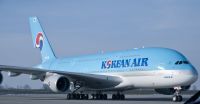 The first A380 for Korean Air has been rolled out of the Airbus paint shop in Hamburg bearing the airline's distinctive livery.
The first A380 for Korean Air has been rolled out of the Airbus paint shop in Hamburg bearing the airline's distinctive livery.
The aircraft is the first of 10 A380s ordered by the airline. Korean Air will become the sixth operator of the A380 when it takes delivery of its first aircraft in the second quarter of this year.
Korean Air will initially operate the A380 on flights from Seoul to Tokyo, Hong Kong and Bangkok, followed later in the year by transpacific services to New York and Los Angeles.
Korean Air will have the least dense accommodation of all A380 operators to date offering 407 seats against Air France, the most congested, with a maximum of 538 passengers. The entire upper deck of the Korean Air aircraft will have 94 flat-bed Prestige sleeper seats. www.koreanair.com
London to lead world with ticketless travel
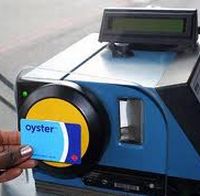 With airline passengers getting used to the idea of ticketless travel (and even cheque books said to be on their way out) Transport for London (TfL) is planning to role out a scheme in 2012 that just involves the swiping of a credit card. This will be across the whole transport network including buses, Tube, DLR, Tram and London Overground.
With airline passengers getting used to the idea of ticketless travel (and even cheque books said to be on their way out) Transport for London (TfL) is planning to role out a scheme in 2012 that just involves the swiping of a credit card. This will be across the whole transport network including buses, Tube, DLR, Tram and London Overground.
By the end of next year card readers across the whole of the TfL network will have been upgraded so that a touch of a contactless bank or credit card will allow passengers to touch in and out for pay-as-you-go travel. The new system will be up and running on all of London's 8,000 buses in time for the 2012 Games, enabling quick and easy bus travel for the millions of visitors expected to flock to the UK capital.
To make the new system possible TfL is upgrading software in the Oyster smartcard system to recognise contactless credit and debit cards issued by Visa, MasterCard and American Express as well as Oyster cards. www.tfl.gov.uk
Manx2 to end Belfast to Cork service
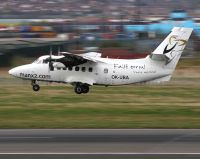 Press reports in Belfast suggest that Manx2 is to stop its service from the dockside airport to Cork at the end of the month, although at the time of writing this could not be verified from the company's website. Manx2 is a virtual airline or ticket provider. It sells seats on a plane but the aircraft is owned and operated separately. It was involved in a fatal crash 10 February on a flight between Belfast and Cork in which six people lost their lives.
Press reports in Belfast suggest that Manx2 is to stop its service from the dockside airport to Cork at the end of the month, although at the time of writing this could not be verified from the company's website. Manx2 is a virtual airline or ticket provider. It sells seats on a plane but the aircraft is owned and operated separately. It was involved in a fatal crash 10 February on a flight between Belfast and Cork in which six people lost their lives.
Lawyers for one of the survivors have accused Manx2 of reneging on its responsibilities after the airline claimed a lawsuit for damages should be taken against the Spanish operators, Flightline BCN. The aircraft was owned by Airlada.
All other flights including from Belfast to Blackpool, Isle of Man and Anglesey are continuing as scheduled. The company also sells seats as Manx2 out of the Isle of Man to various destinations. www.manx2.com
Swiss upgrades its First Class
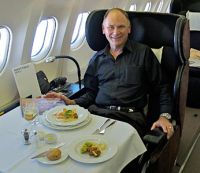 Lufthansa-owned SWISS will this week introduce a new First Class product on its long haul services (Wednesday 2 March).
Lufthansa-owned SWISS will this week introduce a new First Class product on its long haul services (Wednesday 2 March).
Under the new concept guests will enjoy even swifter and more individualised service, together with a wide selection of in-flight meals. Further on-board innovations will include the introduction of contemporary fine bone chinaware and Riedel glasses, together with additional service accessories in a new design.
Customers travelling on night flights will benefit from a quicker service thanks to a new à la carte dining concept that will give them greater choice in how they use their time aloft (or simply a longer sleep).
The new concept means that First Class passengers can decide at any time of the day or night not only what they eat but also when they wish to eat. In another innovation, the selection of gourmet meals available under the award-winning SWISS Taste of Switzerland culinary concept is being further supplemented with traditional Swiss dishes such as bratwurst mit rösti (veal sausage with hash browns). An expanded selection of fresh à la carte fare will also be offered prior to landing. www.swiss.com
Virgin Blue Business Class
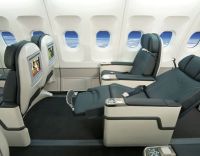 In a first for Virgin Blue, the airline will now offer Business Class on its domestic network. Two brand new Airbus A330 aircraft commence operations in May this year, providing a three times daily service from Sydney to Perth.
In a first for Virgin Blue, the airline will now offer Business Class on its domestic network. Two brand new Airbus A330 aircraft commence operations in May this year, providing a three times daily service from Sydney to Perth.
Virgin Blue Group Chief Executive and Managing Director John Borghetti said: “Our new Business and Economy Class product marks another step forward in our Game Change Programme, which aims to position Virgin Blue as the airline of choice for both the corporate and the leisure markets.”
Features of the new service include a 62-inch seat pitch in Business Class and luxury leather seating, seatback multi-channel in-flight entertainment and a range of high quality food options.
Virgin Blue is Australia's second-largest airline as well as the largest by fleet size to utilise the Virgin brand. The airline serves 28 cities in Australia, with Brisbane Airport as its hub, using 75 narrow-body Boeings and Embraers with four A330-200s on order, all to be delivered this year. www.virginblue.com.au
AND FINALLY: Luton Airport introduces two new staff members
As part of a series of initiatives aimed at simplifying the security process and improving the experience for passengers, Luton Airport has become the first airport in the world to introduce holographic announcers. A lady and gentlemen are being employed to communicate important security messages as passengers pass from check-in to the departure lounge and stand guardian at the top of the stairs before entering the security area.
At the moment they are on trial but should they prove successful passengers can look forward to seeing the couple throughout the airport, in operational roles, offering passenger information and for use by retail outlets within the terminal building. They will probably produce some offspring.
They’ve been nicknamed "Hol ly" and “Graham” (which is tough on the real Holly and Graham, a Doctor and Airline Captain who 'were' friends of your Editor).
If they don’t work there is no question of redundancy. Tensator, global leaders in queue management and digital signage solutions, and creators (of the frighteningly realistic machines) can have them back!
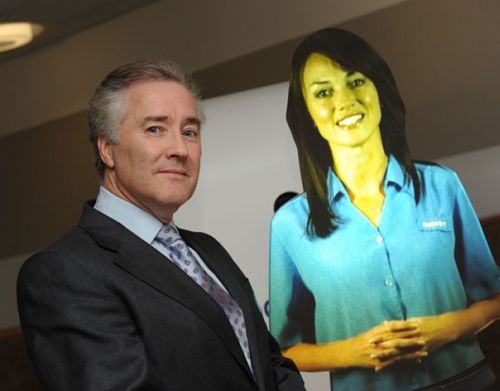
COMMENT: Speed cameras
Before any readers start sending in sympathetic emails, no the editor has not been caught for speeding but he is getting increasingly frustrated with what are legally called safety cameras, are known as speed cameras, and since their introduction have been the cause of endless controversy.
Which? magazine recently published a survey showing that less than 47% of fixed speed traps in England and Wales are operational at any one time. The City of London has only four such cameras and they only work half the time. Bedfordshire has 56 with 77% operational and West Mercia just 20 but the working rate is 100%. Hertfordshire refused to help the magazine.
The real point of discussion is not the actual safety cameras, and here AERBT does believe that they have a value in cutting down accidents, but their implementation and real value.
Our number one complaint is the fact that the speed limit does not go on the yellow box visible to the driver. Why not? The actual speed limit on any particular piece of road is often not easy to see. A particularly bad example is the A40 Hendon Way from London towards Brent Cross. Quite what the legal limit is on part of this road is very difficult to read. If the number were to be painted on the actual boxes there would be no claim that the speed limit could not be seen. It would also be an opportunity to reduce what is known as “street furniture” a definite target of the Department for Transport.
Our other big gripe is the actual speed limits themselves. Who sets them and what are the guidelines? Many are in fact historical and have been in position, often quite correctly, for perhaps as long as 50 years.
But have you recently driven a 50-year-old car? Or even one half that age.
What will become very apparent is that it does not go very well, the brakes will probably be abysmal, and the ride and handling could only be described as poor by today’s standards.
In other words whilst the modern car will be faster, it will stop much quicker and the standard of construction is very much enhanced. From all aspects it will be a safer car.
The 70mph speed limit (which is generally ignored on Motorways) was set when the original Mini could only do 70mph and the Morris Minor 65. 80mph would be much more sensible.
The point is that the 21st century speed limits do not reflect this century’s driving. Gone are the days when cars with Automobile Association badges on them received a salute from the AA men on their motorbikes as they passed by. Yes to 20mph in school areas at certain times.
Which brings us back to the original point. Please, please Mr Department for Transport paint the speed limit on the cameras. AERBT is read in Whitehall. Someone please mention this to them. You may be the next person booked for not knowing how fast you are allowed to go!
Malcolm Ginsberg
Editor in Chief
Baton Rouge hotel re-opens
 IHG (InterContinental Hotels Group) has opened the Hotel Indigo Baton Rouge Downtown Riverfront in Louisiana following a US$25m renovation.
IHG (InterContinental Hotels Group) has opened the Hotel Indigo Baton Rouge Downtown Riverfront in Louisiana following a US$25m renovation.
Once known as the historic Hotel King before being converted to a dormitory during the Depression and then a state office building, the seven-storey building traces its roots back to the 1920s. In 2009, the transformation was begun to restore the building to an upscale boutique hotel reflective of the surrounding community.
Featuring 93 rooms and panoramic views of the Mississippi River or historic Baton Rouge, the hotel maintains much of its original architecture.
Located at the corner of Convention and Lafayette streets – just 400 yards from the Mississippi River – the hotel is just minutes from the central business district. It is within walking distance of the city’s Riverfront Convention Center as well as restaurants, shops and cultural attractions. www.hotelindigo.com
City airport additions to BA portfolio
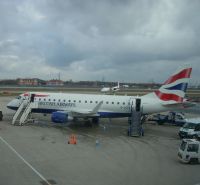 British Airways is to launch two new routes from the Docklands airport to Malaga and Faro in June and add more summer frequency to Ibiza, Nice and Palma.
British Airways is to launch two new routes from the Docklands airport to Malaga and Faro in June and add more summer frequency to Ibiza, Nice and Palma.
The four times a week services to Faro start on 7 June and the three times a week flights to Malaga start on 8 June. Both routes will operate year round.
The existing Nice operation will increase to double daily flights from May until September, and from July to September both Ibiza and Palma flights will be increased from four to 10 a week.
Flights are operated by wholly-owned two-class British Airways’ subsidiary BA CityFlyer, on the new Embraer 170 and 190 aircraft. www.ba.com
Indian hotel for Sofitel
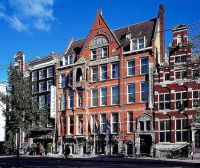 Sofitel, part of the Accor Group, will open nine new hotels globally around the world this year including the first property in India. Located in the centre of Mumbai, in the financial and commercial district, the 302-room hotel will offer French flair and what it calls “decadent amenities” as well as the branded So FIT gym and So Spa.
Sofitel, part of the Accor Group, will open nine new hotels globally around the world this year including the first property in India. Located in the centre of Mumbai, in the financial and commercial district, the 302-room hotel will offer French flair and what it calls “decadent amenities” as well as the branded So FIT gym and So Spa.
One of the most interesting of the new properties is the Sofitel Amsterdam, the Grand, opening as a Sofitel Legend in June 2011, and centred around the city's former Council Chamber and Chambers of Marriage. The hotel also contains the only raw bar in Amsterdam and is within walking distance of the Van Gogh Museum, Royal Palace and Anne Frank's House.
Towards the end of the year the Sofitel Cartagena Santa Clara (Colombia) will open as a Sofitel Legend property, a hotel of significant historical interest. Originally built as a monastery in 1621 it is a landmark within Cartagena's walled city, an area declared a UNESCO World Heritage Site in 1984. The monastery was transformed by Sofitel into a luxury hotel in 1995 and is one of Colombia's most iconic hotels. It contains both Colonial and Republican-style architecture, the hotel walls once acting as part of the defensive structure of the city. Cartagena sits on the Caribbean north east coast of Colombia and is a popular cruise port. www.sofitel-legend.com
Lufthansa adds to South American services race
 Following what is becoming a rush after a trend Lufthansa is adding Rio de Janeiro at the start of the winter season, later this year. The airline joins amongst others whose 2011 plans include British Airways to Buenos Aires, Iberia to Fortaleza and Recife and KLM to Sao Paulo.
Following what is becoming a rush after a trend Lufthansa is adding Rio de Janeiro at the start of the winter season, later this year. The airline joins amongst others whose 2011 plans include British Airways to Buenos Aires, Iberia to Fortaleza and Recife and KLM to Sao Paulo.
The new non-stop service from Frankfurt will be launched on 30 October 2011. Flights will be operated five times weekly with an Airbus A340 configured with 221 seats in a three-class layout with eight passengers in First Class, 48 Business Class, and 165 Economy Class. Flight time is around 12 hours. Rio de Janeiro is one of the venues for the 2014 World Cup in Brazil and will also host the Summer Olympics in 2016. The airline had previously flown to Rio from 1956 until 2005.
Lufthansa is now significantly expanding its services to the region and from next winter will offer 76 flights per week to five destinations in South America. That compares with 42 flights to three destinations in 2007. The new route will complement Lufthansa’s existing services from Frankfurt and Munich to Sao Paolo. www.lufthansa.com
Northern Ireland airport road
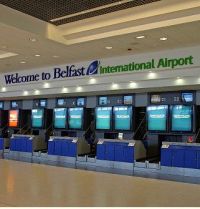 City of Derry Airport has finally now a proper dual carriageway access from Londonderry itself. Last week the £45m A2 scheme was officially opened after two years of congestion and disruption. It involved upgrading nearly five miles of the old single carriageway road.
City of Derry Airport has finally now a proper dual carriageway access from Londonderry itself. Last week the £45m A2 scheme was officially opened after two years of congestion and disruption. It involved upgrading nearly five miles of the old single carriageway road.
The road includes three new roundabouts located at intersections at Campsie, Broadbridge and at the airport. The new road has once again focussed attention as to whether Northern Ireland needs three airports, one (International) of currently around 5m passenger throughput, Belfast City of 2.7m and Londonderry 338,000. The City of Derry Airport has been the subject of an on-off relationship with Ryanair.
The A2 is part of the Northern Key Transport Corridor, the main road connecting Limavady to Derry and provides links to the Maydown and Campsie industrial zones as well as the airport. www.roadsni.gov.uk
Toronto for Ritz-Carlton
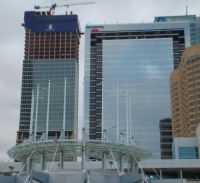 With the worst of the Canadian winter weather now hopefully departed Ritz-Carlton has heralded spring with the opening of a new hotel in Toronto. Located in the heart of the downtown entertainment area and at the crossroads of the financial and performing arts districts, The Ritz-Carlton, Toronto claims to bring a new level of luxury to the city.
With the worst of the Canadian winter weather now hopefully departed Ritz-Carlton has heralded spring with the opening of a new hotel in Toronto. Located in the heart of the downtown entertainment area and at the crossroads of the financial and performing arts districts, The Ritz-Carlton, Toronto claims to bring a new level of luxury to the city.
The 53-storey building features 267 guestrooms including 56 Corner Suites, 2 Deluxe Suites and The Ritz-Carlton Suite at over 2,400sq ft.
With unimpeded north or south facing views of the city or Lake Ontario, all the accommodation offers floor-to-ceiling windows with heated perimeters. The bathrooms feature heated marble flooring, dual vanities embedded with 22” HD television screens, private rain showers and soaker tubs.
The Ritz-Carlton Club Level on floors 18 through 20 includes access to the elegantly-appointed 20th floor Club Lounge, with magnificent water views, personal concierge and continuous complimentary food and beverage presentations throughout the day.
The hotel has a five-storey glass podium at the base of the guestroom tower, which contains the public areas and features the grand foyer lobby with its striking glass bridge, restaurant, bar, lounge and upscale meeting and conference facilities including the city’s largest luxury ballroom. www.ritzcarlton.com
ON TOUR: Ash in Europe
This fascinating report is by Ian Sheppard, MRAeS, aerospace journalist and Managing Editor of Regional International, the journal of the European Regions Airline Association (also Flight International technical reporter, 1997-8)
On 2 February David Learmount, Flight International’s long-time Operations and Safety Editor, gave a lecture exploring the aftermath of the volcanic ash crisis of April/May 2010, when Iceland’s Mt Eyjafjallajökull spewed ash over much of Europe. The talk took place at Brooklands Museum, under the auspices of the Weybridge Branch of the Royal Aeronautical Society (RAeS).
Learmount is somewhat of an expert on this subject having followed it closely both during and afterwards, including at a conference in Iceland and a CANSO (Civil Air Navigation Services Organisation) conference in Oslo. “It’s a very complex subject,” warned Learmount, while showing a stunning image on the projector of an aircraft flying right next to the plume of a volcano. “No wonder airlines got upset when they were grounded when they thought they could do that!”
Overall he noted that estimates put the overall cost of the crisis at anything up to US$1.1tri (OECD estimate), while the EC’s Daniel Calleja Crespo put the direct cost at some €4.7bn. Worryingly, at one of those Icelandic conferences it was announced that it was a “pinhead” compared to some volcanoes in history, even as recently as the last couple of centuries.
He then showed images of the engines of Finnish F-18s which had strayed into the ash cloud, with severe damage to the engine turbine blades, while also pointing out the damage discovered after the BA 747-200 (BA Flight 009) flew into the plume of Mt Galunggung, Jakarta, at night on 24 June 1982. “The ash melts and turns to glass,” said Learmount, stressing that there is, potentially, a serious threat to aircraft safety – but at what concentration levels?
There are lots of different types of volcanic ash. It is very fine and even gets into the cooling channels in blades – not a good situation given that the blades in modern gas turbines operate at above the melting point of the metal used in the blades (without cooling they would break down and fail). “It is analogous to sand in the desert, where higher wind blows up heavy sand not dust, and this sand is abrasive like ash. This can change the aerodynamic shapes of blades and stators.”
So why didn’t the Europeans handle the situation very well?
Historically, before BA 009 there was “no plan” for such an event. From 1982 however ICAO started to set up Volcanic Ash Advisory Centres (VAACs) – of which there are now nine. VAACs report four times a day on any volcanoes which pose a risk, with intensity contour charts. However the Icelandic plume was a good way away from the busiest European airspace. “The airlines were very hacked off,” reflected Learmount, “and they said they knew that they could operate, and even sent aircraft up, and said that there was zero problem. But Airbus sent up an Airbus A340 and said that the airlines didn’t have sampling equipment on their aircraft.”
The upshot of the confusion was that regulators took the view that “guesswork was not good enough – you’ve got to do the science.” The problem was, nobody had done the science.”
“So did Europe have to shut down?” asked Learmount. “NO! At least not to the extent it did... and YES too – as Europe had no contingency plan, not at EC or EASA or national level. [Yet] the knowledge of how to deal with ash events intelligently exists – e.g. the US FAA – but there was not knowledge in Europe.”
Yet he came back to the airline position, little publicised at the time perhaps because they didn’t want to risk being seen as gung-ho: “Airlines said we’re fine because we fly through this stuff quite often.”
One of the main issues was that “every nation took this [problem] as its own and they didn’t talk to each other” – so there was “no contingency plan, no experience and no verifiable technical or operational knowledge [in Europe]. So there was no choice but to default to the safest option.”
Learmount voiced the opinion that “Without the [UK] CAA’s leadership it would have been far worse – without them we wouldn’t have had what we had in one week. The CAA realised that the politicians had to be brought into it. And the politicians realised that they couldn’t meet – so they had to do a teleconference! Then, just as Europe agreed an interim plan, the wind changed and they didn’t need it anyway [yet].”
So what didn’t we know in April? “We know that we still know very little.” Although there was ICAO guidance at the time the thing that stood out and reverberated was ‘AVOID, AVOID, AVOID’. It also said that it would always be possible to fly around the ash cloud – which the Icelandic event showed was not always the case. “It was unique as it was the first time Europe had ash since the [dawn of powered aviation, and the] Wright Brothers.” And this in Europe, “by far the densest area of aviation activity in the world.”
British Airways’ Standard Operating Procedure (SOP) required pilots to fly at least 100 nautical miles from the visible plume, yet “BA’s experience was not logged – it was just anecdotal... you couldn’t expect the CAA to formulate policy on the basis of that!” Furthermore, said Learmount, “BA and Rolls-Royce wouldn’t talk during the event”. In fact, he added, “All the engine manufacturers were very nervous – they were scared that if they [stated a safe] level (g/m3) the lawyers would get them.” (He noted too that manufacturers and airlines are also “to a certain extent scared to death by the lawyers”).
Then, Rolls-Royce came out after the event and stated that a ‘safe level’ would be “some ten times the level assumed by the European agencies,” said Learmount in an exasperated manner, repeating that “Rolls-Royce wouldn’t even talk to the CAA at the time!”
So what’s been done? Learmount expressed his view: “The lack of NAA [National Aviation Authority of which the CAA is the UK’s] coordination is slightly less likely to happen next time. We now have the Aviation Crisis Coordination Cell (ACCC) – but I’ll believe it when it works.”
He noted that the International Volcanic Ash Task Force (IVTF) had started to make progress and that Europe now has a volcanic ash contingency plan covering Europe and the North Atlantic – this is the three-zone system set up after the initial six-day shutdown last April, with a No-Fly Zone (NFZ) at the core, Time-Limited Zone (TLZ) around that, and a Enhanced Procedures Zone (EPZ) around that. “But to go into the TLZ you need to know engine characteristics for your particular aircraft. Also you need an inspection after.” The end result, he noted, was what the operators wanted – for risk management to be transferred from regulators to aircraft operators.
Learmount noted how incredibly “clued up” Alaska Airlines was on the risk of volcanic ash plumes, with pilots doing drills in simulators to prepare for possible ash encounters. “No pilots from Britain, France etc are drilled in this!” The Alaskan guidance is primarily designed for night and low visibility conditions where the ‘plume’ cannot be seen by pilots – with flight plans requiring a route at least 35nm clear of the plume or forecast position of the plume. In addition, “they have radar and video cameras watching the volcanoes. Alaskan takes it very seriously, not a John Wayne attitude [that some think, wrongly, US operators have] at all,” stressed Learmount.
With the Iceland volcano he noted, as has been widely publicised, that “usually when Eyjafjallajökull goes off, Katla [its big sister] goes off a little while later – but it hasn’t done so yet.”
A short discussion followed the lecture which centred primarily on BA Flight 009, which lost all four engines after flying through an ash plume at night. Members of the audience variously noted that the aircraft had been in a terrible state when it returned, having re-lighted the engines once well away from the plume (for example it had been effectively ‘sand-blasted’, and Captain Eric Moody could hardly see out of the cockpit to land).
It was also noted that the scratches often observed in sunlight on aircraft windows are from ash and sand in the atmosphere. Stewart John, former Cathay Pacific Chief Engineer, noted that he had been present when the engines of BA009 (Rolls-Royce RB211 D4 turbofans) were inspected, and they were in a very bad way – although much of the ‘caked’ ash had cleared out of the engines once they flew out of the plume and they could be restarted. He noted the economic impact on the aircraft itself was severe, an engine overhaul costing over US$6m not to mention the impact on its usable life.
Finally, a lady in the audience said that she knew one of the passengers from BA009, who said that the 17 minutes when the aircraft was a ‘glider’ was the longest of their lives!
For a report on the most recent conference on this topic, which was hosted by EASA last month, please see: http://cot.ag/hne1jw
Note – link to CANSO conference report is on David Learmount’s blog at: http://www.flightglobal.com/blogs/learmount/2010/06/can-europe-beat-the-ash-next-t.html
Airline passenger claims
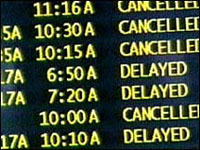 British passengers who suffer flight delays of more than three hours could claim compensation from their airline, following a County Court hearing in Middlesbrough last week.
British passengers who suffer flight delays of more than three hours could claim compensation from their airline, following a County Court hearing in Middlesbrough last week.
The case concerns three Thomas Cook passengers who were claiming compensation for a delay of more than 28 hours on a flight from Manchester to Las Vegas. The Judge ruled in favour of the plaintiffs but the airline successfully applied to have the case ‘stayed’ pending a referral to the European Court of Justice.
Acting for the passengers is a company called EUclaim whose Chief Executive Hendrik Noorderhaven said: “It is vitally important that passengers who may have such claims now pursue them and bring them to the attention of the airlines as soon as possible”.
Under EU law, airlines can cancel flights up to two weeks before departure without paying compensation to its passengers and they do not have to pay in cases of ‘extraordinary circumstances’ which could not have been avoided even if all reasonable measures had been taken, such as unusual technical problems just before take-off. The European Courts of Justice is now likely to have the final word. www.euclaim.co.uk www.auc.org.uk
Boeing's "new" 747
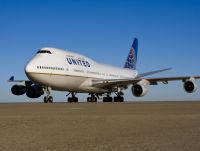 United Airlines has unveiled a Boeing 747-400 in its new rebranding following the merger with Continental Airlines. This is the second ‘new’ 747 in just over a week, Boeing themselves rolling out the lead 747-8i eight days ago.
United Airlines has unveiled a Boeing 747-400 in its new rebranding following the merger with Continental Airlines. This is the second ‘new’ 747 in just over a week, Boeing themselves rolling out the lead 747-8i eight days ago.
With the 374-seat Boeing now repainted in the new livery the carrier has at least one of each of its mainline fleet types carrying the United wording and the Continental tailfin. The airline has completed the respraying of 309 mainline and regional aircraft, which is more than 20% of its total fleet. The ongoing visual restyling of the company will accelerate in the months ahead, and customers will begin to see new airport facilities and advertising. www.united.com
Delta strengthens its position at Heathrow
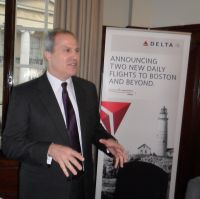 Boston and Miami will be two new destinations for Delta Air Lines at Heathrow from 27 March. The airline is probably the major benefactor of the 2008 North Atlantic “Open Skies” arrangement established at Gatwick before that time and now with up to 10 daily departures out of Europe’s premier gateway.
Boston and Miami will be two new destinations for Delta Air Lines at Heathrow from 27 March. The airline is probably the major benefactor of the 2008 North Atlantic “Open Skies” arrangement established at Gatwick before that time and now with up to 10 daily departures out of Europe’s premier gateway.
Also contributing to its growth is the takeover of Northwest Airlines and its Detroit/Minneapolis routes and membership of Skyteam. The partnership with AF/KLM has given Delta more slot opportunities and Premium Class customers can also use the excellent Alliance lounge in T4. Further slots were acquired via the approval of the American Airlines, British Airways and Iberia marketing arrangement.
Last week Perry Cantarutti, Delta’s Senior Vice-President in Europe, who is based in Air France Paris headquarters, hosted a Delta briefing in London where he noted a strong financial performance in 2010 when the business recorded a US$1.4bn profit. Mr Cantarutti said that the airline's UK regional operations would stay much the same for the coming year and said that the carrier’s presence at Gatwick would continue. “With a daily service Atlanta has performed well.” www.delta.com
KLM to Buenos Aires
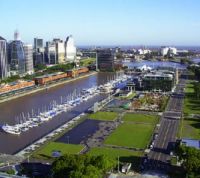 Amsterdam (AMS) is the latest European gateway to offer direct non-stop services to Buenos Aires, KLM returning after a 10 year gap. The 11hr flights will be operated by two-class Boeing 777-200ER aircraft, ideally suited to the operation with 35 passengers in World Business Class and 283 in Economy.
Amsterdam (AMS) is the latest European gateway to offer direct non-stop services to Buenos Aires, KLM returning after a 10 year gap. The 11hr flights will be operated by two-class Boeing 777-200ER aircraft, ideally suited to the operation with 35 passengers in World Business Class and 283 in Economy.
Buenos Aires, with 14m inhabitants, is one of the most important destinations in the fast growing Argentinean market and a very popular business and tourist destination for European travellers with the Netherlands an important import/export trading partner.
The revived route to Buenos Aires Ezeiza Airport will be operated three times per week from the start of next winter. A frequency increase to four times per week in March 2012 is foreseen. www.klm.com
Luton airline's ecoflights
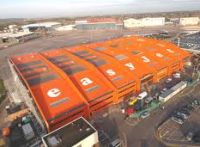 easyJet, with 50m passengers annually and close on 200 aircraft, is now Britain’s largest airline. It is also becoming the most forward thinking (readers may recall the “ecoJet” of June 2007 – said to be still alive).
easyJet, with 50m passengers annually and close on 200 aircraft, is now Britain’s largest airline. It is also becoming the most forward thinking (readers may recall the “ecoJet” of June 2007 – said to be still alive).
easyJet’s latest initiative is lightweight, thin nanotechnology polymer coating. It works by reducing build up of debris and reduces drag across the surface of the aircraft thus reducing the fuel bill and is estimated could save 1-2% annually equating to a £14m reduction in fuel costs.
Eight aircraft have been painted with the weight added an astonishing 113g (4oz). The idea has already been used by US Military. The experiment will last for 12 months and if successful easyJet will apply the paint to its whole fleet. www.easyJet.com
Peter Joel of Pan Am passes away
 One of life's true gentlemen Peter Joel was Pan Am’s British PR man at the time of the Lockerbie air disaster. With the airline’s Directors literally locked up in their Grand Central New York office his task was unenviable but even that he carried out with dignity.
One of life's true gentlemen Peter Joel was Pan Am’s British PR man at the time of the Lockerbie air disaster. With the airline’s Directors literally locked up in their Grand Central New York office his task was unenviable but even that he carried out with dignity.
Peter's career began as a reporter at the Surrey Comet which led to posts on other papers and journals including Travel Trade Gazette. In the 1970s he joined Pan Am as Public Relations Director, Pan Am UK. He was a past Chairman for the Airline Public Relations Organisation (APRO).
Peter went through Pan Am’s Tenerife airport disaster and then the living nightmare that was Lockerbie, a pivotal time in so many respects: the speed of communication, terrorist activity, mass media interest. Peter was in the thick of it with none of the support and training that airline staff receive today.
Peter carried that trauma of Lockerbie with him for the rest of his life and suffered poor health for some years before his death.
Travelodge expands
 Cardiff city centre (South Wales), Paignton seafront (Devon), Horsham town centre (West Sussex) and Southgate (North London) are the latest destinations to be added by Travelodge, which claims to be Britain’s fastest growing hotel chain. Under construction is a further 36 properties.
Cardiff city centre (South Wales), Paignton seafront (Devon), Horsham town centre (West Sussex) and Southgate (North London) are the latest destinations to be added by Travelodge, which claims to be Britain’s fastest growing hotel chain. Under construction is a further 36 properties.
In a review of the year Guy Parsons, Travelodge CEO, noted that the company, owned by Dubai International Capital, saw 70 new openings in 2010. “The deal with Mitchells and Butlers, acquiring 52 of their hotels, shows the innovative approach we have taken towards our aggressive growth plans.”
In a progress statement he reported sales in London up 16% and the Provinces up 12%. Total rooms sold rose by 13% to 7m.
Over half of the Travelodge hotels being developed are situated in major UK cities. There are eight hotels being built in London, with three opening this year – this will mean Travelodge will become the largest single hotel brand in the capital this spring.
In addition there are three hotels being built in Birmingham, including NEC and two city centre locations. In Manchester Travelodge is opening at the MEN arena and at the University. There are also city centre hotel openings in Bristol, Cambridge, Canterbury, Cardiff, Hull, Lancaster and Liverpool. www.travelodge.co.uk
CRUISE NEWS February 2011
The annual Daily Telegraph Cruise Show returns to Olympia’s Grand Hall 26-27 March 2011. Whether you are new to cruising and need help to plan your first ever voyage, or a seasoned cruiser looking for inspiration for your next holiday at sea, it has quickly established itself as a MUST. On the Sunday there are no parking restrictions. Olympia has its own Underground station and is also part of London Overground with frequent services to both Clapham and Willesden Junctions with connections at either end. Polar cruise specialist Explore! and Great Rail Journeys, who combine rail travel with leisurely river cruises are among the newcomers this year, joining regular exhibitors including NCL, Fred Olsen Cruise Lines, Orient Express, P&O Cruises, Royal Caribbean International and Silversea. The Cruise Show is packed with features, expert advice, exclusive show-only offers and competition from exhibitors making it the ideal day-out to gather inspiration for your next cruise. Tickets are £6 in advance or £10 on the day, for more information visit www.cruisingshow.co.uk
This month's ship review: Independence of the Seas
John Chatterley reports
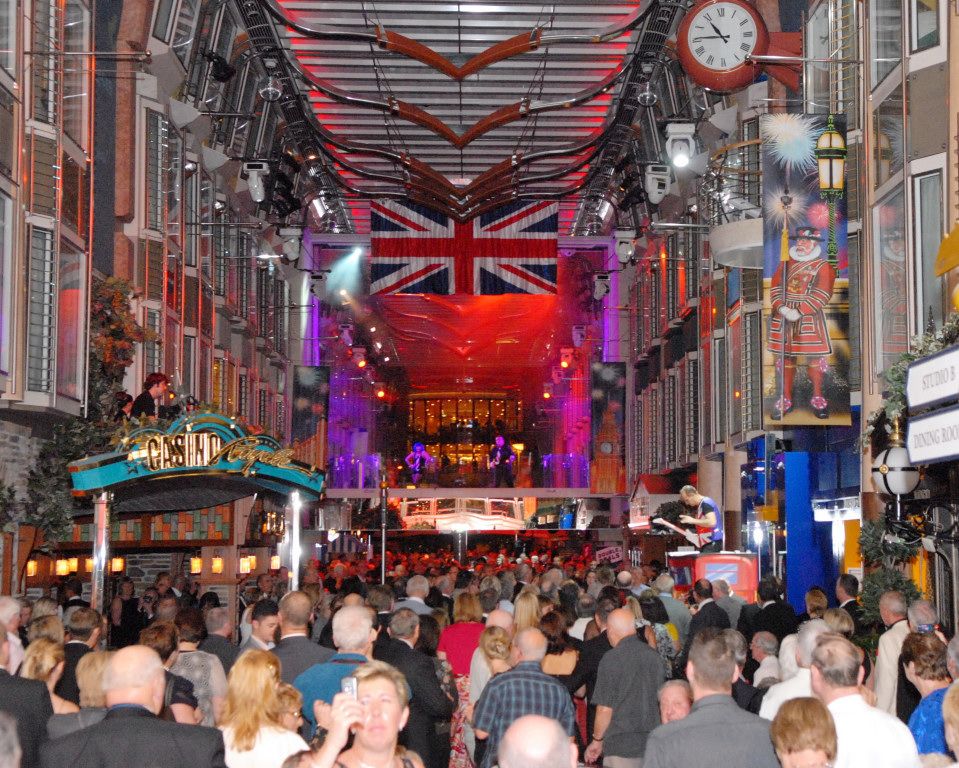 When reading cruise reviews I have found many featuring a great number of negative elements, which can be enlightening, so long as they're taken with a pinch of salt and the understanding that they were probably written by people who are inherently extremely hard to please.
When reading cruise reviews I have found many featuring a great number of negative elements, which can be enlightening, so long as they're taken with a pinch of salt and the understanding that they were probably written by people who are inherently extremely hard to please.
My wife and I escaped the UK weather last December after securing an exceptional price reduction on Royal Caribbean (RCCL) – Independence of the Seas – leaving Southampton on 10 December for the warmth of the Canaries.
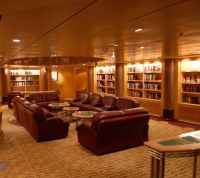 We like to think of ourselves as experienced cruisers but this was our first cruise with RCCL and was booked before I had looked at any reviews. After reading the first couple of reviews, I realised that I may have been too hasty in making the booking before doing the usual checks. One such review stated that there were 800 children on board, some creating havoc, with not a parent in sight, but that shouldn’t detract from the many that, I am sure, had a fabulous time.
We like to think of ourselves as experienced cruisers but this was our first cruise with RCCL and was booked before I had looked at any reviews. After reading the first couple of reviews, I realised that I may have been too hasty in making the booking before doing the usual checks. One such review stated that there were 800 children on board, some creating havoc, with not a parent in sight, but that shouldn’t detract from the many that, I am sure, had a fabulous time.
With an obvious emphasis on families it may be tempting to believe that child-free cruisers will be overrun by children. However, as you would expect on a ship of this size there are the peaceful areas, and as this cruise was just prior to Christmas children were not in abundance and those on the cruise were in the main well behaved.
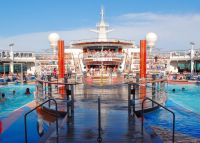 For youngsters there is a range of age related activities and facilities – Babies & Tots (6 to 36 months); Adventure Ocean (3 groups covering 3 to 11 years); Teens (two groups covering 12 to 17 years).
For youngsters there is a range of age related activities and facilities – Babies & Tots (6 to 36 months); Adventure Ocean (3 groups covering 3 to 11 years); Teens (two groups covering 12 to 17 years).
Independence of the Seas went into service in May 2008, has a 154,407 GRT, is 1,112ft long and 185ft wide with a cruising speed of 21.6 knots. It has 1,817 staterooms of which 1,084 are Ocean View (842 with balconies), 733 Interior staterooms (172 Promenade View).
Embarkation
The embarkation was trouble free and was the most efficient we have experienced. We arrived at the terminal at around 12 noon, dropped our cases at the luggage point, then went and parked the car, after which we had a short walk back to the departure lounge. A friendly welcome at check-in, then straight through security and we were on the ship.
Cabins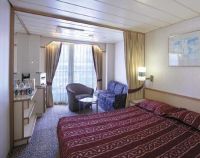 We were advised on arrival that cabins were not available until 14:00, so whilst waiting we had lunch in the Windjammer restaurant. Our roomy balcony cabin was on deck 9, it was spotlessly clean and extremely well designed and had a spacious open wardrobe, flat screen TV and a small but adequate en suite bathroom. Whilst cabins have kettles, only tea bags are supplied, but having read the reviews, we were aware of this and brought our own coffee – and the teabags were so weak you felt like giving them the kiss of life, they were totally flavourless.
We were advised on arrival that cabins were not available until 14:00, so whilst waiting we had lunch in the Windjammer restaurant. Our roomy balcony cabin was on deck 9, it was spotlessly clean and extremely well designed and had a spacious open wardrobe, flat screen TV and a small but adequate en suite bathroom. Whilst cabins have kettles, only tea bags are supplied, but having read the reviews, we were aware of this and brought our own coffee – and the teabags were so weak you felt like giving them the kiss of life, they were totally flavourless.
Food and Beverages
There are three main restaurants, King Lear, Romeo & Juliet and Othello with the Windjammer Café for breakfast and lunch, but it also opens for dinner for the non-conformists. King Lear dining was to very high standard with excellent service. Other eateries are available, but with a small cover charge.
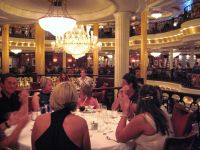 The centrepiece is the Royal Promenade on deck 5 with its Café Promenade (open 24 hours a day), Sorrento’s Pizza, Dog and Badger Pub, Wine Bar, Ben and Jerry’s Ice Cream Parlour and much more. The Promenade Café is and can be a relaxing area to have morning coffee or afternoon tea, whilst ‘people watching’. Also along the Royal Promenade are several shops, including Clean Shave barbers shop, Clothes and Souvenir shops plus a General Store.
The centrepiece is the Royal Promenade on deck 5 with its Café Promenade (open 24 hours a day), Sorrento’s Pizza, Dog and Badger Pub, Wine Bar, Ben and Jerry’s Ice Cream Parlour and much more. The Promenade Café is and can be a relaxing area to have morning coffee or afternoon tea, whilst ‘people watching’. Also along the Royal Promenade are several shops, including Clean Shave barbers shop, Clothes and Souvenir shops plus a General Store.
Johnny Rockets, a 50s style diner, boasts a menu of favourites including juicy hamburgers, classic sandwiches, and milk shakes. Cruisers also enjoy that all-American look with tabletop jukeboxes and authentic decor.
There are many bars and lounges around the ship, our favourite being Olive and Twist, terrific views and great music.
Entertainment  The entertainment was excellent – considering there are families across the age range, the balance was good. Special mention to Mr Joff Eaton (Cruise Director) who was excellent.
The entertainment was excellent – considering there are families across the age range, the balance was good. Special mention to Mr Joff Eaton (Cruise Director) who was excellent.
The Royal Promenade is also the place to be for the fun of the big parade – some of the biggest smiles and obvious enjoyment during the Disney type parade were on the faces of the oldies.
The entertainment in the theatre was always good but the ice shows are a must, get your tickets early as they are limited. There were quiz sessions, 'keep fit', aerobics, and dance instruction. Oh yes, I can’t forget the Bingo, in fact the American assistant Cruise Director wouldn’t allow you to forget it, with his constant “Hi De Hi” announcements – I can feel a complaint coming on!
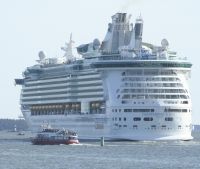 Cruising can be relaxing, but if you prefer to be more active on your cruise, Independence of the Seas has a great many options for sport and recreation. There is an ice skating rink, a rock climbing wall, a fitness centre, a full-size boxing ring and a day spa and fitness centre as well as the Flowrider (onboard surfing). Other entertainments include a nine-hole miniature golf course and a casino.
Cruising can be relaxing, but if you prefer to be more active on your cruise, Independence of the Seas has a great many options for sport and recreation. There is an ice skating rink, a rock climbing wall, a fitness centre, a full-size boxing ring and a day spa and fitness centre as well as the Flowrider (onboard surfing). Other entertainments include a nine-hole miniature golf course and a casino.
With Royal Caribbean we had an exceptional cruise and there is virtually nothing really negative to be reported from our 11 days on board.
Something for everyone is practically guaranteed on RCCL Independence of the Sea. Remember it’s not the cruise it’s the cruisers that can be the problem. www.rccl.com
OUR TEN-STORY NEWS REVIEW
AmaWaterways will introduce one brand new river cruise ship and one that has undergone a complete rebuild during 2011.
In September 2011 the brand-new MS AmaLotus will join MS La Marguerite, to sail the Vietnam, Cambodia and the Riches of the Mekong itinerary.
The ship features all-outside accommodations and 226sq ft staterooms. Some 90% of staterooms have a private outside balcony, while suites, at 624sq ft, provide the ultimate in onboard pampering.
AmaLotus features a restaurant serving Asian and Western specialties as well as an authentic Vietnamese ‘Lau’ (Hot Pot) dining facility. In addition, there is a lounge, gift shop, spa, fitness room and sauna. The styling is very ethnic. The Sun Deck has a dip pool.
The completely rebuilt MS AmaKatarina will be inaugurated on 10 May and is claimed to the most luxurious vessel on the Volga-Baltic Waterway travelling from St. Petersburg to Moscow. The AmaKatarina is being restructured starting from the hull and designed to meet AmaWaterways’ demanding specifications. The ship is unequalled in terms of spaciousness, accommodations and enticing public areas. The only luxury vessel in Russia featuring outside balconies in over 70% of its staterooms, AmaKatarina’s four-suite categories range in size from 280 to 432sq ft.
The public areas aboard AmaKatarina include two dining rooms offering complimentary wine and soft drinks at dinner; a beautiful Panorama Lounge; bar/nightclub; conference hall and solarium. The ship also features an elevator, gift shop, infirmary and internet access. www.amawaterways.co.uk
Azamara Club Cruises has unveiled 54 itineraries ranging from five to 16 nights, between March 2012 and February 2013, aboard Azamara Journey and Azamara Quest the 694-berth former R series boutique ships. Following a popular trend 51% of all port calls in 2012 feature late night and overnight stays in port, providing time for guests to enjoy more of the area and take advantage of the evening in destinations where the nightlife is vibrant.
In 2012 both ships will operate in the Mediterranean during the peak European season with a variety of cruises which includes the Monaco Grand Prix.
Azamara Quest will sail to South American destinations during the height of their summer, beginning with a 13-night Brazil voyage that departs Barbados on 5 December 2012 and concludes with an overnight at Rio De Janeiro. The Christmas in South America voyage, departing 18 December, offers guests daily port calls as well as an overnight in Punta Del Esta (Uruguay), with its miles of beautiful beaches, luxury hotels and restaurants, and glittery nightlife; and the cosmopolitan city of Buenos Aires (Argentina).
Guests on the 27 December ex-Rio nine-night voyage are in for a real treat when, on New Year’s Eve, Azamara Quest positions itself off of Copacabana Beach to offer guests an unforgettable view of the midnight fireworks over the sea.
Azamara Journey follows ancient spice trade routes and colonial heritages around the Indian subcontinent to East Asia, starting with a 13-night Spice Coast & Ceylon voyage from Bombay (Mumbai) to Madras (Chennai – India), departing 29 November 2012. On 23 December, Azamara Journey embarks on an exciting 14-night Southeast Asia voyage to Hong Kong, offering two-night calls at Bangkok (Klong Toey – Thailand), and Ho-Chi Minh City (Vietnam), and an overnight at Hanoi in the UNESCO World Heritage Site of Halong Bay.
Britain’s third annual National Ferry Fortnight will take place this year between 14 and 28 May, industry body the Passenger Shipping Association (PSA) has confirmed. Supported by all ferry line members of the PSA, the two-week showcase was created to heighten consumer and media awareness of Britain’s extensive ferry services of over 50 routes.
Continuous investment in modern, versatile fleets has seen more people travelling by ferry, with some 35m passengers, 8m cars and over 140,000 coaches carried in 2010. PSA members including Brittany Ferries, Condor Ferries, DFDS Seaways, Hovertravel, Isle Of Man Steam Packet Company, Irish Ferries, LD Lines, P&O Ferries, Red Funnel, Sea France, Stena Line and Wightlink will take part in National Ferry Fortnight.
Central to the campaign will be a series of promotional offers on ferry routes to the Continent, Ireland and UK islands which will be announced nearer the date and promoted on the www.discoverferries.co.uk website.
Crystal Cruises is returning to Alaska this coming season for the first time since 2005.
Crystal Symphony will make nine 12-night round-trip sailings from San Francisco from May through August to Victoria, Vancouver, Sitka, Juneau, Skagway/Haines, Ketchikan and either Hubbard Glacier or Glacier Bay.
The “six-star” line is placing much emphasis on the off ship excursions noting that guests can explore the state’s waterways by safari boat, private catamaran, white-water raft, canoe, kayak or WWII duck vehicle. They can view the breathtaking landscapes and wildlife by seaplane or helicopter, or stay planted on terra firma in a horse-drawn trolley, ATV, jeep, sled, motorcycle, old-fashioned railcar, private Hummer or Unimog 4x4. Extreme adventurers can rock climb, flyfish or zipline over rainforest canopies.
For gourmet experts local cuisine such as alderwood-smoked salmon, fresh halibut chowder and all-you-can-eat crab will be showcased Crystal-style via cooking classes, wilderness camp dining and a five-course Alaskan Chef’s Table in Ketchikan. www.crystalcruises.com
Hebridean Princess, the 50-passenger luxury cruise ship favoured by HM The Queen has completed her annual winter refit. Key renovations have been made including the introduction of two new single grade cabins, each with their own private facilities. For 2011 new itineraries include the Grand Cruise to the North and St Kilda, An East Coast Adventure and the Grand Celtic Cruise providing guests with the opportunity to further explore the dramatic British coastline and discover new waters in Northern France and Ireland.
Later this summer, Hebridean Princess will journey to Portsmouth, joining fellow All Leisure Holidays vessels, mv Discovery and mv Minerva. All three ships will have summer sailings from Portsmouth during 2011. www.hebridean.co.uk
L’Austral is the latest ship to join La Compagnie du Ponant's existing fleet, the fifth in a series of mega-yachts. With 132 cabins it is the result of the expertise of the Italian Fincantieri shipyard and French sophistication. So many personal touches create the spirit of a “private yacht”. Guests will encounter unique itineraries, calls inaccessible to large ships, chic and elegant yacht-like ambiance, refined and personalised service, as well as gastronomic cuisine.
Just as on a private yacht, passengers are free to do as they wish at their own pace. All the crew on board the fleet are totally fluent in both English and French.
L’Austral’s inaugural season features her seven-night maiden voyage from Marseilles to Lisbon, departing 27 April; and will then operate itineraries to discover the treasures of the Mediterranean, Dalmatian Coast and North & West Africa. www.ponant.com
London is to gain a proper cruise terminal in time for the 2012 Olympics. Ships of up to 50,000 tons, about the size of Crystal Symphony, will be able to use the facility.
Greenwich Council has approved plans to provide docking facilities at Enderby Wharf on the south side of the Thames close by the National Maritime Museum which will include a 251-room hotel. Enderby House, a Grade II-listed building, will be extended to provide tourist, community and retail facilities as part of the plan. Waterbus services will be provided towards the O2 Arena, Canary Wharf and the various landing stations towards Westminster.
A Transport for London cable car link across the River Thames is also planned, linking the Greenwich Peninsula with the Royal Victoria Dock in Newham.
Ships that use the site will have to moor well out in the river due to the tides. Access problems will be overcome by the use of a docking facility in deep water linked by a bridge. Customs and immigration facilities will be provided.
Work is expected to start later this year and whilst the scheme will not be fully operational for several years July 2012 has been targeted for an initial opening. Approval is required by the Mayor of London but this is considered a formality. www.greenwich.gov.uk/Greenwich
Princess Cruises is to broadcast live the Royal wedding of Prince William and Kate Middleton on 29 April. Passengers will be able to follow full coverage of the BBC’s broadcast across all Princess ships with its popular “Movies under the Stars” screens. Popcorn and blankets will be provided where the timings mean an evening event. (In some time zones the broadcast may be delayed for viewing at a convenient hour and all transmissions are subject to satellite availability.
Celebration parties will also be hosted onboard including special Royal-themed cocktails, Royal wedding trivia and a William and Kate look-alike contest.
“As this is the first Royal wedding in some years we know there will be huge interest not only from our British passengers, but our international passengers too. We at Princess also feel a connection with Prince William because his mother, Princess Diana, christened our original Royal Princess back in 1984,” said Pieter van der Schee, Head of Brand Marketing, Princess Cruises UK. www.princess.com
Saga’s two ships Ruby and Pearl II will be visiting a number of ports that are completely new to the specialist operator this year, including Halmstad in Sweden, Ørsta on Norway’s west coast and the historic city of Split in Croatia. At the present time Ruby is on a World Cruise, sailing east, whilst Pearl II is meandering around the Caribbean before returning to Southampton towards the end of March and a full European season.
The Saga Group is synonymous with the over fifties but its cruising arm is also unique in the British market in that it is a direct sales organisation and the ships themselves are a one sitting dining operation with all service charges included. www.saga.co.uk
Star Clippers, the tall ship sailing specialist, are to bring Star Flyer to the UK next year for the first time since the vessel's launch in 1991. This remarkable 170-passenger vessel is a real head turner, and is operated manually, with the help of power winches, by a 72-man crew (including a few ladies).
During summer, Star Flyer will cruise out of Copenhagen, Hamburg, Oslo and Stockholm as well as to and from Southampton. Star Flyer will be seen in the Solent and harboured in the British port on 5 May and 1 September 2012, attracting plenty of attention with her four masts, thousands of square feet of sail and graceful lines, modelled on the great clipper ships of the 19th century.
She then departs for a five-night voyage to Hamburg, via Amsterdam – a unique chance to sail on a genuine tall ship from a British port, with two days at sea included, on which there will be plenty of chance to relax on the teak decks, learn about the wind, stars and navigation or even help the crew hoist the sails. The five-night sailing costs from £1,035 per person, including all meals on board and port taxes, excluding return flights from Hamburg.
The September visit includes an inbound cruise from Hamburg once again, and outbound to Lisbon. www.starclippers.co.uk


